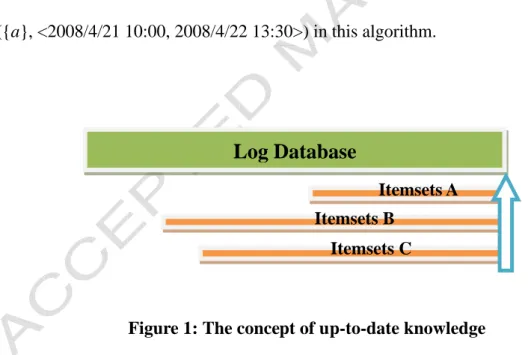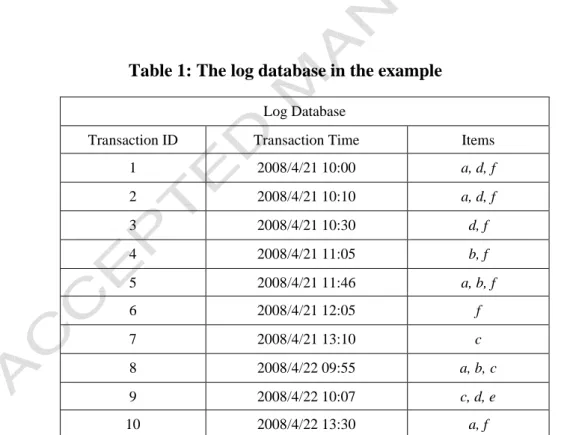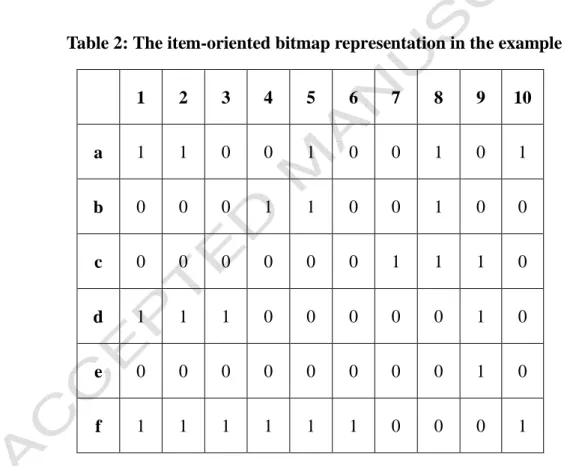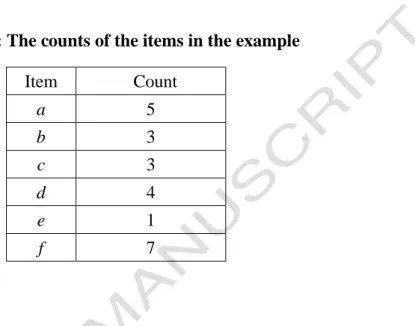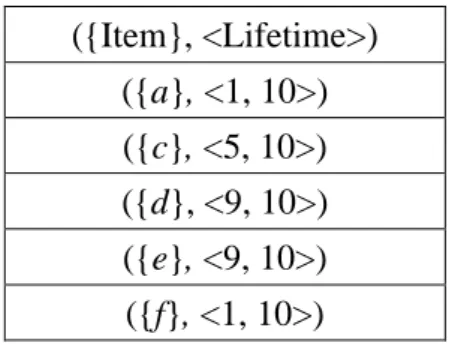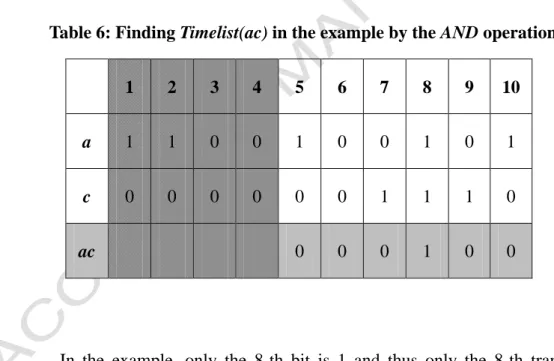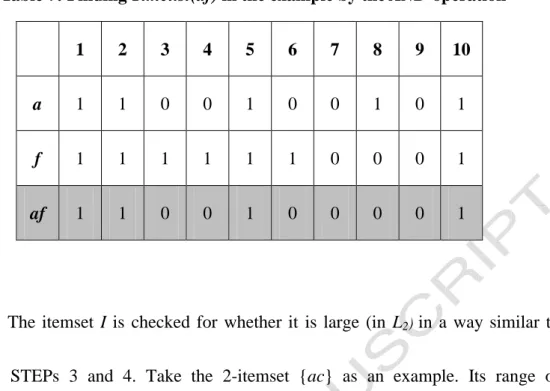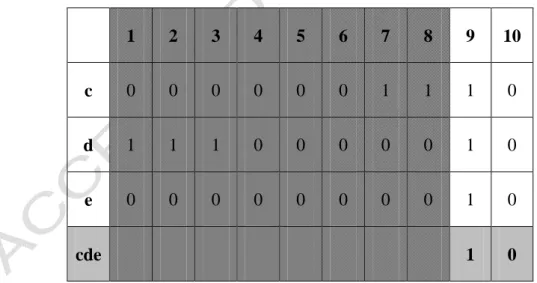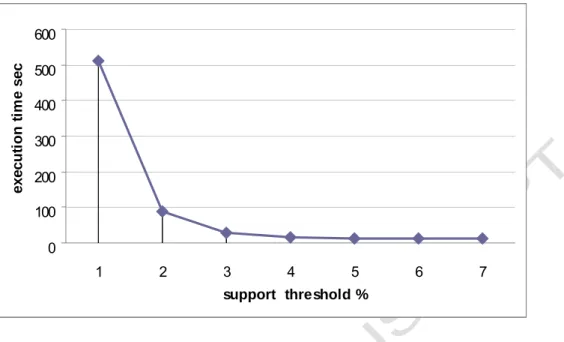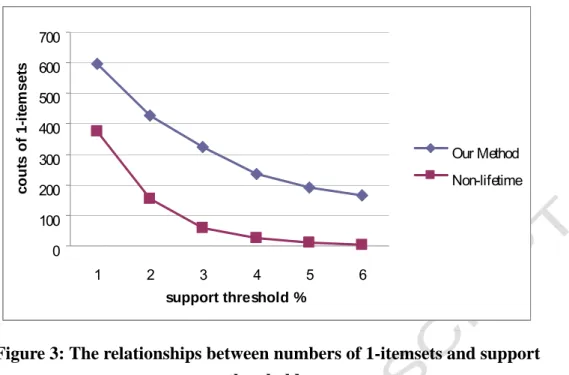Accepted Manuscript
An effective mining approach for Up-to-date patterns Tzung-Pei Hong, Yi-Ying Wu, Shyue-Liang Wang
PII: S0957-4174(09)00167-5
DOI: 10.1016/j.eswa.2009.02.029
Reference: ESWA 3527
To appear in: Expert Systems with Applications
Please cite this article as: Hong, T-P., Wu, Y-Y., Wang, S-L., An effective mining approach for Up-to-date patterns, Expert Systems with Applications (2009), doi: 10.1016/j.eswa.2009.02.029
This is a PDF file of an unedited manuscript that has been accepted for publication. As a service to our customers we are providing this early version of the manuscript. The manuscript will undergo copyediting, typesetting, and review of the resulting proof before it is published in its final form. Please note that during the production process errors may be discovered which could affect the content, and all legal disclaimers that apply to the journal pertain.
ACCEPTED MANUSCRIPT
An Effective Mining Approach for Up-to-date
Patterns*
Tzung-Pei Hong1,2, Yi-Ying Wu3and Shyue-Liang Wang4
1Department of Computer Science and Information Engineering 3Department of Electrical Engineering
4
Department of Information Management
National University of Kaohsiung, Kaohsiung, 811, Taiwan
2Department of Computer Science and Engineering
National Sun Yat-sen University, Kaohsiung, 804, Taiwan
Abstract
Mining association rules is most commonly seen among the techniques for knowledge discovery from databases (KDD). It is used to discover relationships among items or itemsets. Furthermore, temporal data mining is concerned with the analysis of temporal data and the discovery of temporal patterns and regularities. In this paper, a new concept of up-to-date patterns is proposed, which is a hybrid of the association rules and temporal mining. An itemset may not be frequent (large) for an entire database but may be large up-to-date since the items seldom occurring early may often occur lately. An up-to-date pattern is thus composed of an itemset and its up-to-date lifetime, in which the user-defined minimum support threshold must be satisfied. The proposed approach can mine more useful large itemsets than the conventional ones which discover large itemsets valid only for the entire database. Experimental results show that the proposed algorithm is more effective than the traditional ones in discovering such up-to-date temporal patterns especially when the minimum support threshold is high.
Keyword: data mining, temporal patterns, up-to-date patterns, lifetime.
*This is a modified and expanded version of the paper “Mining up-to-date knowledge from log data”, presented at the IEEE International Conference on Granular Computing, 2008, China,
ACCEPTED MANUSCRIPT
1.
Introduction
Knowledge discovery in databases (KDD) is to identify effective, coherent, and useful information in large databases [10]. Through years of research in KDD, a variety of data-mining techniques have been developed. According to the type of databases processed, the mining approaches may be classified as working on transaction databases, temporal databases, relational databases, multimedia databases, and stream database, among others. There are also many mining methods proposed in KDD, such as techniques for association rules, classification rules, clusters, sequential patterns and so on. In particular, association rules have been most used in KDD [3][4][8][11][12][14][15]. They are used to describe correlation relationships among items or itemsets in transactional databases and have successful applications in many areas.
Many algorithms based on the Apriori algorithm [1], which generated candidate itemsets in a top-down level-wise process, were proposed to mine association rules. When the percentage of transactions containing a candidate itemset is greater than or equal to a user-specified minimum support threshold, the itemset is called as a frequent (large) one and thought of as possessing correlation relationships among the items included.
ACCEPTED MANUSCRIPT
recently. It is concerned with the analysis of temporal data and the discovery of temporal patterns and the regularities in temporal datasets. It typically reveals ordered correlation of itemsets in transactions along with time. For example, consider a database from a retail store. The sales of ice cream in summer and the sales of mitten in winter should be higher than those in the other seasons. Such seasonal behavior of specific items can only be discovered when a proper window size is chosen for the mining process [6]. But a fixed window size may also hide some information about the items.
In this paper, the concept for up-to-date patterns is described. Each itemset is attached an up-to-date lifetime, in which the user-defined minimum support threshold must be satisfied. In some cases, an itemset may not be frequent (large) for an entire database but may be large up-to-date since the items seldom occurring early may often occur lately. The up-to-date patterns thus include the itemsets which are frequent for a flexible period of time from the current to the oldest past time. Up-to-date patterns are practical in the field of data mining because they can provide more useful information for the current usage than traditional ones. For example, the counts of be mined patterns by up-to-date approach are larger than traditional data mining, consequently, we can find more effective association rules. Also, Up-to-date information is usually important to making decisions. For example, a newly
ACCEPTED MANUSCRIPT
announced product such as i-phone may not be discovered as a frequent item from the whole market transaction database. It may, however, be mined in time by the proposed approach. Market managers can thus make effective decisions for marketing strategy.
The remainder of this paper is organized as follows. Related works are reviewed in Section 2. The up-to-date patterns from a log database and the proposed mining algorithm are described in Section 3. An example to illustrate the proposed algorithm is given in Section 4. Experiments for verifying the effectiveness of the above approach are stated in Section 5. Conclusion and future work are given in Section 6.
2.
Review of Related Works
In this section, some related researches about mining association rules are briefly reviewed. They are data mining for association rules and temporal data mining.
2. 1
Data Mining for Association Rules
Data mining technology has become increasingly important in the field of large databases and data warehouses. This technology helps discover non-trivial, implicit,
ACCEPTED MANUSCRIPT
previously unknown and potentially useful knowledge, thus being able to help managers make good decisions. Among the various types of databases and mined knowledge, mining association rules from transaction databases is the most interesting and popular [1][2][4][8][11][14][15][23]. In general, the process of mining association rules can roughly be decomposed into two tasks:
(1) Finding frequent (large) itemsets satisfying a user-specified minimum support threshold from a given database, and
(2) Generating interesting association rules satisfying a user-specified minimum confidence threshold from the frequent itemsets found.
A variety of mining approaches based on the Apriori [3] algorithm were proposed, such as DIC [13], DHP [12], Sampling, and FP-Growth [9]. Each of them was designed for a specific problem domain, a specific data type, or for improving its efficiency.
2. 2
Temporal Data Mining
Association-rule mining discovers unordered correlations between items from a given database. However, temporal data mining reveals ordered correlations from databases with time. More formally, temporal data mining is concerned with the
ACCEPTED MANUSCRIPT
analysis of temporal data to find out temporal patterns and regularity from a set of data with time. Temporal patterns can be discovered in a variety of forms, like sequential association rules [5], periodical association rules [23], cyclic association rules [19], and calendar association rules [18].
The calendar time expression [22] is widely used to specify the features of temporal patterns. A calendar time expression is composed of calendar units in a specific calendar and may represent different time features, such as an absolute time interval over the time domain, a periodic time over the time domain, or a periodic time within a specific time period. However, it is very difficult to choose a right period of time such that the associations of particular interest can be found from the transaction data. Besides, since different items may have different exhibition periods in a log database, considering a fixed window size of each item might not lead to a fair measurement. Therefore in this paper, we propose a flexible algorithm with different effective lifetimes for items, focusing on the most recent itemsets.
3.
The Proposed Approach for Mining Up-to-date Patterns from
Log Databases
ACCEPTED MANUSCRIPT
information is usually important to making decisions. In traditional data mining, an itemset may not be frequent (large) for an entire database but be large up-to-date since the items occurring early may not occur lately. Finding up-to-date knowledge is thus very interesting and practical in the field of data mining. The concept of up-to-date knowledge is shown in Figure 1.
For example, supposed user set a minimum support is 5%, and the database are consist of 100 transactions, thus, an item can be extracted if the occurrence of the item have to be larger than 5, in other words, if an item a occur only 4 times in the database, it would not be extracted. On the contrary, we may extract the pattern like ({a}, <2008/4/21 10:00, 2008/4/22 13:30>) in this algorithm.
Figure 1: The concept of up-to-date knowledge
In Figure 1, an up-to-date pattern is a frequent (or called large) pattern with a valid lifetime, in which the end point is the current time. Its start time will make the lifetime as long as possible. It is a little like the concept of slide windows that it only
Log Database
Itemsets C Itemsets A Itemsets B
ACCEPTED MANUSCRIPT
care the most recent itemsets in a fixed length. In this algorithm, we not only care about the whole database, but also care the most recent itemsets in a non-fixed length. Formally, an up-to-date pattern is defined as follows.
Definition: An up-to-date pattern is a pair ({Itemset}, <Lifetime>), where the
first term Itemset is a set of items and is large from a database duration the lifetime which is the second term in the pair. The end value of the lifetime is the current time and no other lifetime for the itemset may last longer than it.
According to the above definition, an algorithm is proposed in this section to find all the up-to-date patterns from a given log database. It first translates the log database into an item-oriented bit-map representation to speed up the execution in the later mining process and then extracts large itemsets valid with the longest lifetime from the past to the current time. The proposed approach can mine more useful large itemsets than the conventional ones which discover large itemsets valid only for the entire database. Before the algorithm is described, the notation used in this paper is first defined below.
ACCEPTED MANUSCRIPT
D: the log database;
n: the number of transactions in D; I: an item or an itemset;
T(I): the number of occurrences of itemset I in D; Min_Sup: the support threshold for large itemsets;
r: a parameter that used to keep the current number of items in the itemset;
Si: the short-lifetime i-itemsets in which an itemset needs to shorten its lifetime to be
large;
Li: the set of large i-itemsets from D;
Ci: the set of all candidate i-itemsets from D;
Timelist(I): the set of transaction IDs in which itemset I appears; First(I): the first transaction ID in Timelist(I);
Lifetime(I): the period of time in which I is large.
3. 2
The Proposed Algorithm
The details of the proposed algorithm are described below.
Mining up-to-date patterns from a log database:
INPUT: A log database D with n transactions stored in the order of transaction time, each of which includes transaction ID, transaction time, items, and among others, and a minimum-support threshold Min_Sup.
OUTPUT: A set of up-to-date itemsets with their corresponding lifetimes.
STEP 1: Transform the given log database into the item-oriented bitmap representation, in which the j-th bit for item I is set as 1 if the j-th
ACCEPTED MANUSCRIPT
transaction contains I and is set as 0 otherwise.
STEP 2: For each item I, find out from the bitmap representation the transactions in which item I appears. Let Timelist(I) represents the above set of transactions for I in the order of transaction IDs. Calculate the count of each item I in Timelist(I) as the number of 1’s and put the count into T(I).
STEP 3: Check whether the count T(I) of each item I is larger than or equal to the minimum count, which is n*Min_Sup. If it is, put ({I}, <1, n>) in the large 1-patterns (L1); If it is not, put the item I in the set of short-lifetime
1-itemsets (S1).
STEP 4: For each item I in the set of S1, do the following substeps.
Substep 4-1: Set First(I) as the first transaction ID in Timelist(I).
Substep 4-2: Calculate whether the item I is frequent during the lifetime <First(I), n> by the following formula:
1
_ T I n First I Min Sup ;If the item I satisfies the above condition, then put the pattern ({I}, <n – (T(I)/Min_Sup) + 1, n>) in L1; Otherwise, set
First(I) as the next transaction ID in Timelist(I), decrease the
count of T(I) by one, and repeat this substep until T(I) is equal to zero or the above condition is satisfied.
ACCEPTED MANUSCRIPT
STEP 5: Set r = 1, where r is used to keep the current number of items in the itemset to be processed.
STEP 6: Generate the candidate set Cr+1 from Lr in a way similar to the Apriori
algorithm, except that the start ID in the possible lifetime of an (r+1)-itemset in Cr+1 is the maximum of the start IDs of the r-itemsets
forming the (r+1)-itemset.
STEP 7: For each (r+1)-itemset I in Cr+1, use the AND operator on the possible
lifetime bits and mask the other bits to find Timelist(I) from the bitmap representation.
STEP 8: Find the large (r+1)-pattern (Lr+1) of I in a way similar to STEPs 3 and 4.
STEP 9: If Lr+1 is null, do the next step; Otherwise, set r = r + 1 and repeat STEPs 6
to 8.
STEP 10: In order to reduce the number of large pattern and save the memory space, keep the closed frequent itemsets to substitute for all large pattern. Thus, no superset that is frequent with the same lifetime. Transform the transaction IDs in the lifetimes into the actual occurring times and output the transformed up-to-date patterns to users.
ACCEPTED MANUSCRIPT
or hashes, can be used to speed-up the execution. Besides, after the patterns are found, the association rules can also be easily derived.
4.
An Example
In this section, an example is given to illustrate the proposed up-to-date mining algorithm from a log database. Table 1 shows the log database to be used in the example. The database contains 10 transactions and 6 items, denoted a to f.
Table 1: The log database in the example
Log Database
Transaction ID Transaction Time Items
1 2008/4/21 10:00 a, d, f 2 2008/4/21 10:10 a, d, f 3 2008/4/21 10:30 d, f 4 2008/4/21 11:05 b, f 5 2008/4/21 11:46 a, b, f 6 2008/4/21 12:05 f 7 2008/4/21 13:10 c 8 2008/4/22 09:55 a, b, c 9 2008/4/22 10:07 c, d, e 10 2008/4/22 13:30 a, f
Assume the minimum-support threshold is set at 50%. The proposed algorithm proceeds as follows.
ACCEPTED MANUSCRIPT
STEP 1: The given log database is first transformed into the item-oriented bitmap representation. Take item a as an example. It appears in transactions 1, 2, 5, 8 and 10, and the corresponding bits are thus set as 1. After STEP 1, the obtained bitmap representation for the transactions in Table 1 is shown in Table 2.
Table 2: The item-oriented bitmap representation in the example
1 2 3 4 5 6 7 8 9 10 a 1 1 0 0 1 0 0 1 0 1 b 0 0 0 1 1 0 0 1 0 0 c 0 0 0 0 0 0 1 1 1 0 d 1 1 1 0 0 0 0 0 1 0 e 0 0 0 0 0 0 0 0 1 0 f 1 1 1 1 1 1 0 0 0 1
STEP 2: The transactions in which item I appears can be easily found out from the bitmap representation. Take item a as an example. It can be easily obtained from Table 2 that the bit map for item a is {1, 1, 0, 0, 1, 0, 0, 1, 0, 1}.
ACCEPTED MANUSCRIPT
Timelist(a) is thus {1, 2, 5, 8, 10}. Besides, the count T(I) of each item I can
be easily found from the number of 1’s in its bit map. The results after Step 2 are shown in Table 3.
Table 3: The counts of the items in the example
Item Count a 5 b 3 c 3 d 4 e 1 f 7
STEP 3: The count T(I) of each item I is compared with the minimum count. In the example, since the minimum support is set at 50% and there are ten transactions, the minimum count is thus 10*0.5, which is 5. Among the items, the counts of items a and f are larger than the minimum count. They are thus frequent for the whole database and the two patterns, ({a}, <1, 10>) and ({f}, <1, 10>) are put in L1. On the contrary, the counts of items b, c, d
and e are smaller than the minimum count, they are then put into the set of short-lifetime 1-itemsets (S1). Thus S1 = {b, c, d, e}.
STEP 4: The following two substeps are done for each item I in the set of S1.
ACCEPTED MANUSCRIPT
Timelist(I). Take item c as an example to illustrate the step. It
can be easily found from Table 2 that First(c) is 7.
Substep 4-2: The item I is checked during the lifetime <First(I), n> by the given formula:
1
_ T I n First I Min Sup .In the example for item c, the range of the transactions with item c is 10-7+1 (= 4), which is less than the count T(c) of item
c divided by the minimum support (3/0.5). Item c is then a large
1-pattern. Its start ID is calculated as 10- 3/0.5+1, which is 5, according to the formula in the algorithm. The pattern ({c}, <5, 10>) is thus put in L1. For item b, the range of the transactions
with item b is 10-4+1 (= 7), which is larger than the count T(b) of item b divided by the minimum support (3/0.5). The variable
First(b) is then moved to the next transaction ID in Timelist(b),
which is 5. The count of b is decreased by one, becoming 2, and Substep 4-2 is repeated again. In this example, item b is found not an up-to-date pattern until T(b) is equal to zero. After the step, the results are shown in Table 4.
ACCEPTED MANUSCRIPT
Table 4: The obtained up-to-date 1-patterns in the example
({Item}, <Lifetime>) ({a}, <1, 10>) ({c}, <5, 10>) ({d}, <9, 10>) ({e}, <9, 10>) ({f}, <1, 10>)
STEP 5: The variable r is set at 1, where r is used to keep the current number of items in the itemset to be processed.
STEP 6: The candidate set C2 is generated from L1. The start ID of a 2-itemset is the
maximum of the start IDs of the two items in the 2-itemset. Take the candidate 2-itemset {ac} as an example. Lifetime(ac) is generated from
Lifetime(a) (<1, 10>) and Lifetime(c) (<5, 10>). Since the maximum of the
two start IDs is 5, Lifetime(ac) is thus <5, 10>. After STEP 6, the resulting candidate set C2 is shown in Table 5.
Table 5: The resulting candidate set C2in the example ({Itemset}, <Lifetime>) ({ac}, <5, 10>) ({ad}, <9, 10>) ({ae}, <9, 10>) ({af}, <1, 10>) ({cd}, <9, 10>) ({ce}, <9, 10>) ({cf}, <9, 10>)
ACCEPTED MANUSCRIPT
({de}, <9, 10>) ({df}, <9, 10>) ({ef}, <9, 10>)
STEP 7: For each 2-itemset I in C2, its Timelist(I) is found from the bitmap
representation by the AND operation. Take the candidate 2-itemset {ac} as an example. Since Lifetime(ac) is <5, 10>, only the ones from the 5-th to the 10-th bits for items a and c are operated, and the other bits are masked as 0. The process is shown in Table 6.
Table 6: Finding Timelist(ac) in the example by the AND operation
1 2 3 4 5 6 7 8 9 10
a 1 1 0 0 1 0 0 1 0 1
c 0 0 0 0 0 0 1 1 1 0
ac 0 0 0 1 0 0
In the example, only the 8-th bit is 1 and thus only the 8-th transaction needs to be further considered for the itemset {ac}. Take another candidate 2-itemset {af} as an example. Its possible lifetime is <1, 10>. The process is shown in Table 7.
ACCEPTED MANUSCRIPT
Table 7: Finding Timelist(af) in the example by the AND operation
1 2 3 4 5 6 7 8 9 10
a 1 1 0 0 1 0 0 1 0 1
f 1 1 1 1 1 1 0 0 0 1
af 1 1 0 0 1 0 0 0 0 1
STEP 8: The itemset I is checked for whether it is large (in L2) in a way similar to
STEPs 3 and 4. Take the 2-itemset {ac} as an example. Its range of transactions is 10-8+1 (= 3), which is larger than the count T(ac) of itemset {ac} divided by the minimum support (1/0.5). The count of {ac} is then decreased by one, becoming 0. The loop then stops for the itemset {ac} and it is not a large pattern. For the 2-itemset {af}, its range of transactions is 10-1+1 (= 10), which is larger than the count T(af) divided by the minimum support (4/0.5). The variable First(af) is then moved to the next transaction ID in Timelist(af), which is 2. The count of {af} is decreased by one, becoming 3. Substep 4-2 is then repeated again. Finally, the large 2-pattern ({af}, <9, 10>) is found and put in L2. After the step, the results are shown
ACCEPTED MANUSCRIPT
Table 8: The obtained up-to-date 2-patterns in the example
({Itemset}, <Lifetime>) ({af}, <9, 10>) ({cd}, <9, 10>) ({ce}, <9, 10>) ({de}, <9, 10>)
STEP 9: Since L2 is not null, r is set at 2 and STEPs 6 to 8 are repeated. In the
example, the only candidate 3-itemset is ({cde}, <9, 10>). Its Timelist is then found from the bitmap representation by the AND operation. The process is shown in Table 9.
Table 9: Finding Timelist(cde) in the example by the AND operation
1 2 3 4 5 6 7 8 9 10
c 0 0 0 0 0 0 1 1 1 0
d 1 1 1 0 0 0 0 0 1 0
e 0 0 0 0 0 0 0 0 1 0
cde 1 0
The itemset {cde} is then checked for whether it is large (in L3) in a way
similar to STEPs 3 and 4. The 3-pattern ({cde}, <9, 10>) is found to be large and put in L3. In this example, no candidate 4-itemsets are generated.
ACCEPTED MANUSCRIPT
The next step is then executed.
STEP 10: All the up-to-date patterns are found. And check whether up-to-date patterns are closed frequent itemsets. In the example, up-to-date 3-patterns ({cde}, <9, 10>) is closed frequent itemsets, that contains the up-to-date 2-patterns ({cd}, <9, 10>), ({ce}, <9, 10>), ({de}, <9, 10>) and up-to-date 1-patterns ({d}, <9, 10>), ({e}, <9, 10>), that with the same lifetime. On the contrary, the up-to-date 1-patterns ({c}, <5, 10>) is keep, because there are no superset that is frequent with the same lifetime. All the transaction IDs in the lifetime are transformed into the actual occurring times according to the database, and the patterns are then output to users. The final up-to-date patterns are shown in Table 10
Table 10 The final up-to-date patterns in the example
( {Itemset}, <Lifetime> ) ( {a}, <2008/4/21 10:00, 2008/4/22 13:30>) ( {c}, <2008/4/21 11:46, 2008/4/22 13:30>) ( {f}, <2008/4/21 10:00, 2008/4/22 13:30>) ( {af}, <2008/4/22 10:07, 2008/4/22 13:30>) ( {cde}, <2008/4/22 10:07, 2008/4/22 13:30>)
From the results, it can be seen that each itemset may have its own valid lifetime pattern as the up-to-date knowledge. Note that some patterns will not be found from
ACCEPTED MANUSCRIPT
the original mining algorithms. Since up-to-date knowledge is usually important for making decisions, the proposed approach is expected to provide some effective reference values to users or managers.
5.
Experimental Results
In the section, we describe the implementation details of the proposed algorithm for mining up-to-date patterns from a log database. They were implemented in C on an AMD Athlon 64 Processor 3200+ personal computer with 1.99GHz and 1GB RAM. The IBM database, T10I4D100K, was used to verify the proposed approach. In the database, the size of a transaction was 10, the size of potential maximal large itemsets was 4, and the number of transactions was 100000.
In order to make an efficient execution, the bitmap data structure was used to speed up both the I/O access and the program execution. The proposed approach was compared to the traditional method that mined frequent itemsets without up-to-date patterns. Different minimum support values were set in the experiments.
In the first experiment, the relationships between execution times and minimum supports are shown. The minimum supports varied from 1% to 7%. The results are shown in Figure 2.
ACCEPTED MANUSCRIPT
0 100 200 300 400 500 600 1 2 3 4 5 6 7 support threshold % e x e c u ti o n t im e s e cFigure 2: The relationships between execution times and support threshold
It can be observed that the curve of execution times is close to zero when the support threshold is above 3% for the dataset. The execution times increase sharply when the support threshold changed from 2% to 1%. This is because when the support threshold is low, the number of up-to-date patterns dramatically increased.
Next, the relationships between the numbers of 1-itemsets for different minimum support thresholds are shown in Figure 3. It is clear that the number of frequent itemsets discovered by the proposed mining algorithm for up-to-date patterns was larger than that by the traditional method without considering lifetime.
ACCEPTED MANUSCRIPT
0 100 200 300 400 500 600 700 1 2 3 4 5 6 support threshold % c o u ts o f 1 -i te m s e ts Our Method Non-lifetimeFigure 3: The relationships between numbers of 1-itemsets and support thresholds
The relationships between the numbers of 2-itemsets and 3-itmesets for different minimum support thresholds are shown in Figures 4 and 5, respectively. It can be observed that the counts of the 2-itemsets and 3-itemsets without up-to-date patterns method are close to zero when the support threshold was set at above from 1%. Restated, rare frequent 2-itemsets and 3-itemsets were generated. The same as before, by the proposed method for up-to-date patterns, the number of frequent itemsets discovered are much more than that by the traditional one. Besides, the rules from a high support threshold are usually more important than those form a low support threshold. When the support threshold increased, more up-to-date patterns with shorter lifetimes would be generated. Since finding patterns with a large support threshold is usually more important than that with a small one, the proposed approach
ACCEPTED MANUSCRIPT
can find more useful knowledge than the traditional one for a large support threshold.
0 500 1000 1500 2000 2500 1 2 3 4 5 6 support threshold % c o u n ts o f 2 -i te m s e ts Our Method Non-lifetime
Figure 4: The relationships between numbers of 2-itemsets and support
thresholds 0 1000 2000 3000 4000 5000 6000 1 2 3 4 5 6 support threshold % c o u n ts o f 3 -i te m s e ts Our Method Non-lifetime
Figure 5: The relationships between numbers of 3-itemsets and support
ACCEPTED MANUSCRIPT
6.
Conclusion and Future Work
In this work, we have described the concept of up-to-date temporal patterns and have proposed an approach to discover such patterns from a temporal dataset. An example illustrating the proposed algorithm is also given. Experimental results show that the proposed algorithm is more effective than the traditional mining methods in discovering such up-to-date temporal patterns. Especially when the large support is high, the proposed approach has much more association rules than the traditional ones, which derive very rare rules. In the future, we may study using appropriate data structures to speed up the execution time. We will also further investigate the enhancement of the proposed up-to-date model.
References
1. R. Agrawal, T. Imielinksi and A. Swami, “Mining association rules between sets of items in large database,“ The ACM SIGMOD Conference, Washington DC, USA, 1993.
2. R. Agrawal, T. Imielinksi and A. Swami, “Database mining: a performance perspective,” IEEE Transactions on Knowledge and Data Engineering, Vol. 5, No. 6, pp. 914-925, 1993.
ACCEPTED MANUSCRIPT
3. R. Agrawal and R. Srikant, “Fast algorithm for mining association rules,” The
International Conference on Very Large Data Bases, pp. 487-499, 1994.
4. R. Agrawal, R. Srikant and Q. Vu, “Mining association rules with item constraints,” The Third International Conference on Knowledge Discovery in
Databases and Data Mining, Newport Beach, California, 1997.
5. R. Agrawal, R. Srikant, “Mining sequential patterns,” The 7th International
Conference on Data Engineering, pp. 3-14, 1995.
6. J. F. Roddick and M. Spiliopoulou, “A survey of temporal knowledge discovery paradigms and methods,” IEEE Transactions on Knowledge and Data
Engineering, pp. 750-767, 2002.
7. H. Mannila, M. Informatic, I. Stadtwaldt and H. Toivonen, “On an algorithm for finding all interesting sentences,” The 13th European Meeting on Cybernetics and
Systems Research, pp. 973-978, 1996.
8. J. Han and Y. Fu, “Discovery of multiple-level association rules from large database,” The 21st International Conference on Very Large Data Bases, Zurich, Switzerland, pp. 420-431, 1995.
9. J. Han, J. Pei, and Y. Yin, “Mining frequent patterns without candidate generation,” ACM SIGMOD Conference, pp. 1-12, 2000.
10. W. J. Frawley, G. P. Shapiro and C. J. Matheus, “Knowledge discovery in databases: an overview,” The AAAI Workshop on Knowledge Discovery in
Databases, pp.1-27, 1991.
11. H. Mannila, H. Toivonen and A. Inkeri Verkamo, “Efficient algorithm for discovering association rules,” The AAAI Workshop Knowledge Discovery in Databases, pp. 181-192, 1994.
12. J. S. Park; M. S. Chen; P. S. Yu, “Using a hash-based method with transaction trimming for mining association rules,” IEEE Transactions on Knowledge and
ACCEPTED MANUSCRIPT
Data Engineering, pp.812-825, 1997.
13. S. Brin, R. Motwani, J. D. Ullman and S. Tsur, “Dynamic itemset counting and implication rules for market basket data,” The ACM SIGMOD Conference, Tucson, Arizona, USA, pp. 255-264, 1997.
14. R. Srikant and R. Agrawal, “Mining generalized association rules,” The 21st
International Conference on Very Large Data Bases, Zurich, Swizerland, pp.
407-419, 1995.
15. A. Savasere, E. Omiecinski and S. Navathe, “An efficient algorithm for mining association rules in large databases,” The ACM VLDB Conference, pp. 432-444, 1995.
16. B. Liu, W. Hsu and Y. Ma, “Mining association rules with multiple minimum supports,” The 1999 International Conference on Knowledge Discovery and Data
Mining, pp.337-341, 1999.
17. K. Wang, Y. H and J. Han, “Mining frequent itemsets using support constraints,”
The 26th International Conference on Very Large Data Bases, pp. 43-52, 2000.
18. Y. Li, P. Ning, X. S. Wang and S. Jajodia. “Discovering calendar-based temporal association rules,” Data & Knowledge Engineering, pp. 193-218, 2003.
19. B. Ozden, S. Ramaswamy and A. Silberschatz. “Cyclic association rules,” The
14th International Conference on Data Engineering, Orlando, Florida, USA, pp.
12-421, 1998.
20. J. W. Lee, Y. J. Lee, H. K. Kim, B. H. Hwang and K. H. Ryu. “Discovering temporal relation rules mining from interval data,” The First EurAsian Conference
on Information and Communication Technology (Eurasia-ICT 2002), Shiraz, Iran,
pp, 57-66, 2002.
21. J. M. Ale and G. H. Rossi. “An approach to discovering temporal association rules,” The 2000 ACM Symposium on Applied Computing, Villa Olmo, Italy, pp.
ACCEPTED MANUSCRIPT
294-300, 2000.
22. K. Verma, O.P. Vyas and R. Vyas. “Temporal approach to association rule mining using T-tree and P-Tree,” Lecture Notes in Computer Science, Vol. 3587, 2005, pp. 651 – 659.
23. D. Li and J. S. Deogun, “Discovering partial periodic sequential association rules with time lag in multiple sequences for prediction,” Lecture Notes in Computer
Sciences, Vol. 3488, 2005, pp. 332-341.
24. M. S. Chen, J. Han and P. S. Yu, “Data mining: An overview from a database perspective,” IEEE Transactions on Knowledge and Data Engineering, Vol. 8, No. 6, 1996.
25. X. Chen, I. Petrounias and H. Heathfield, “Discovering temporal association rules in temporal databases,” The International Workshop on Issues and Applications of
